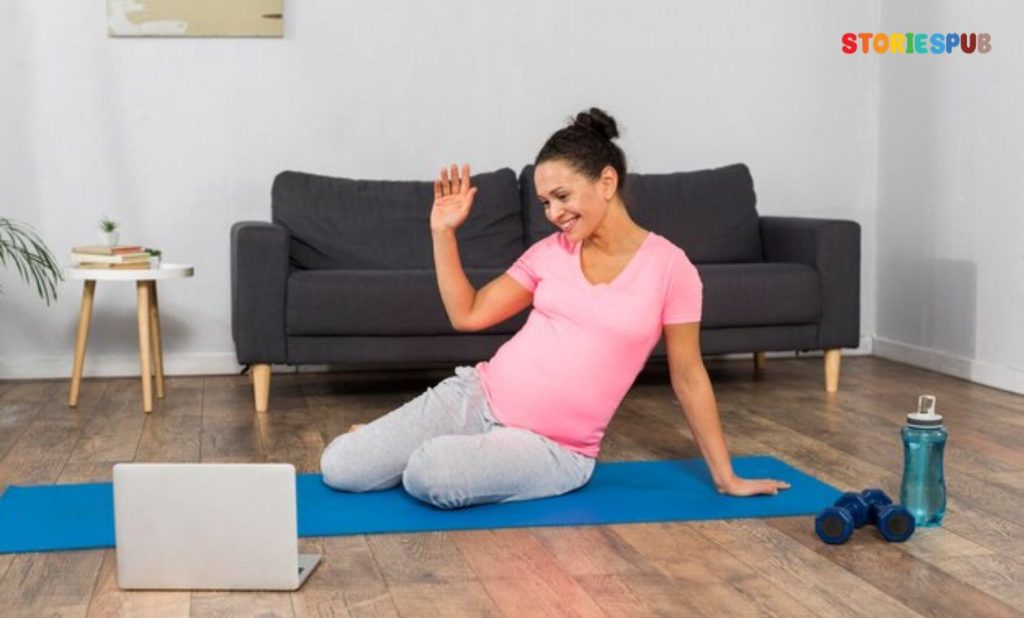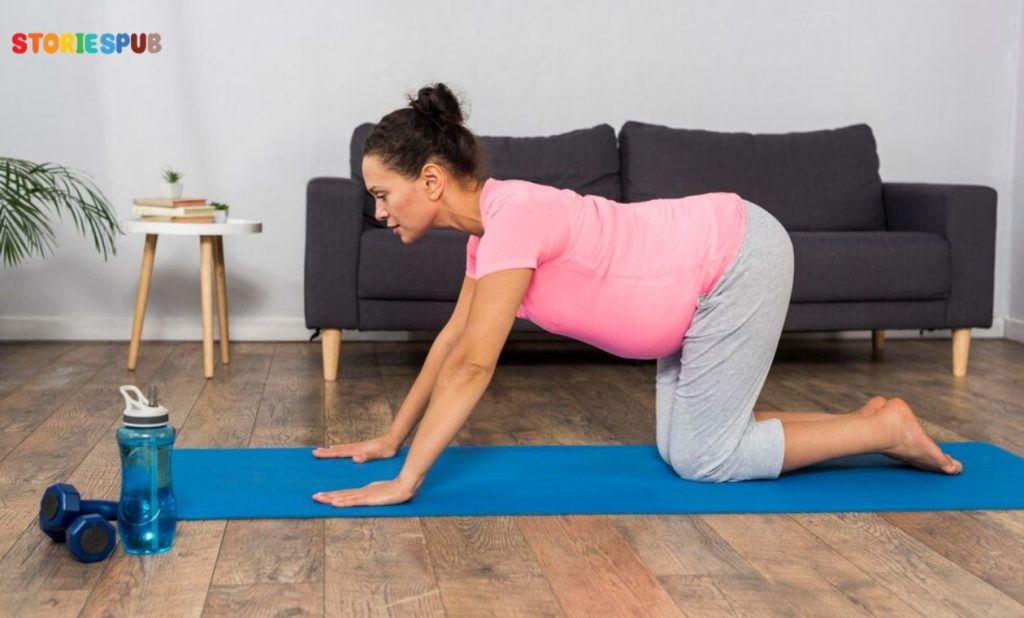
Welcoming a new life into the world brings immense joy but also introduces changes to your body. From loose skin to extra weight, the journey back to your pre-baby body is a common goal. However, approaching postpartum exercise requires patience and a mindful strategy to avoid unnecessary strain and injuries.
Before delving into effective tips, let’s explore the numerous benefits of postpartum exercise. Beyond aiding in regaining your pre-baby physique, it fosters short-term advantages like baby-weight loss and improved muscle tone, essential for the demands of caring for a newborn. Furthermore, embracing an active lifestyle establishes positive habits, ensuring a healthier long-term future.
The mental and emotional well-being derived from postpartum exercise is equally significant. Elevating mood, reducing postpartum depression, and boosting energy levels contribute to an overall sense of vitality. Whether opting for a solo workout or joining a fitness class, exercise becomes a multifaceted endeavor, serving as self-care and, at times, valuable social time.
Now, armed with motivation, let’s explore the 13 Tips for Postpartum Exercise

1) Consult with Your Doctor First
Initiate your postpartum exercise journey by consulting with your doctor. Their guidance ensures a safe and tailored approach, addressing any specific considerations based on your health and delivery. Engage in this conversation before leaving the hospital, setting the foundation for a well-informed exercise plan.
2) Allow Your Body to Recover
Recognize the monumental changes your body has undergone during pregnancy and childbirth. Grant yourself a week or two of recovery before embarking on an exercise program. This essential healing period supports physical recuperation and hormone stabilization.
3) Gradual Progression is Key
Regardless of your pre-pregnancy fitness level, initiate postpartum exercise with gradual and gentle activities. Walking, light calisthenics, and stretching serve as initial testing grounds, allowing you to understand your body’s post-baby capabilities.
4) Embrace Realistic Goals
Acknowledge and embrace your starting point. Whether a five-minute walk or basic stretching, focus on what you can comfortably achieve. Small, achievable goals build momentum for gradual progression.
5) Opt for Suitable Postpartum Exercises
Choose low-impact exercises such as walking, swimming, water aerobics, or yoga, especially if you’re just starting. Classes designed for new moms, like Strollercize or Baby Boot Camp, offer a supportive and social exercise environment.
6) Prioritize Pelvic Floor Exercises
Incorporate pelvic floor exercises (Kegels) into your routine to gradually strengthen this vital area. Not only do these exercises aid in preventing issues like urine leakage and pelvic organ prolapse, but they also contribute to postpartum recovery.
7) Communicate with Class Instructors
Participating in exercise classes postpartum? It’s vital to keep your class instructors in the loop about your recent childbirth. By openly sharing this information, you ensure that the instructors can make necessary adjustments to the workout routine, taking into consideration the unique needs and challenges of your postpartum body.
This open communication is a key step in creating a safe and inclusive exercise environment tailored to your specific requirements, enhancing the overall experience and effectiveness of your workouts.
8) Exercise with a Companion
Finding motivation for postpartum exercise becomes more manageable when you have a workout companion. This companion could be a friend, a family member, or even your baby. Exercising with someone else not only makes the workout more enjoyable but also provides a support system. The presence of a companion can offer encouragement, making it easier to stay motivated and accountable.

If your chosen workout partner is your baby, you can engage in activities like stroller walks or incorporate them into specific exercises, creating a bonding experience while staying active. This social aspect of exercising adds a positive dimension to the journey, making it both enjoyable and sustainable.
9) Gentle Approach to Abdominal Exercises
Respect the changes in your abdominal muscles post-pregnancy. Skip traditional sit-ups and crunches initially and opt for exercises like planks, which offer effective toning without excessive strain. Consult with your doctor for personalized advice.
10) Prioritize Supportive Bras
Invest in a supportive sports bra suitable for various exercises. This ensures comfort during activities such as walking, stretching, or swimming. For breastfeeding moms, proper bra support is crucial, and additional products like Mustela’s Soothing Moisturizing Balm or Bust Firming Serum can alleviate discomfort.
11) Gradual Introduction of Weighted Exercises
Transitioning into weighted exercises postpartum should be a gradual process, prioritizing the rebuilding of muscle strength. Start with body-weight exercises as a foundational step before progressing to more advanced movements like pushups, pull-ups, and squats. This phased approach ensures a safe and steady transition, allowing your body to adapt and gain strength progressively.
12) Nourish Your Body
Recognize the interconnectedness of nutrition and exercise in your postpartum fitness journey. A well-balanced diet, particularly important for breastfeeding moms, complements your efforts in postpartum fitness, contributing to overall well-being. Adequate hydration is also crucial to support your body during and after exercise, enhancing the effectiveness of your fitness routine.
13) Attune to Your Body’s Signals
While the desire to regain pre-baby fitness is strong, it’s equally important to be attuned to your body’s signals. If you encounter fatigue, prolonged muscle soreness, shaky muscles, or an elevated resting heart rate, consider these cues as indicators to modify your workout routine.
Prioritizing your well-being over pushing yourself too hard ensures a sustainable and health-focused approach to postpartum exercise.
Conclusion.
embracing postpartum exercise is a positive step towards overall well-being for new moms. The benefits extend beyond physical health, encompassing mental and emotional wellness. It’s important to start slowly, respecting your body’s recovery process, and consulting with your healthcare provider before commencing any exercise routine.
Choosing the right exercises, such as walking, swimming, or yoga, tailored to your comfort and fitness level, can make the journey enjoyable. Classes designed for new moms provide not only a chance to work out but also a supportive social environment.
Pelvic floor exercises, like Kegels, play a crucial role in postpartum recovery, contributing to both physical and sexual health. Understanding the changes in abdominal muscles and opting for suitable exercises, like planks, ensures a safe and effective fitness journey.
Communication with your exercise instructor, wearing a supportive sports bra, and incorporating your baby into workouts add to the positive experience. Additionally, maintaining a balanced diet with proper hydration complements the benefits of postpartum exercise.
Listening to your body is key; if you experience signs of overexertion, it’s essential to take a break and seek guidance. Postpartum exercise is not just about reclaiming your pre-baby body but is a holistic approach to self-care, enabling you to be at your best for both yourself and your little one. Always prioritize your well-being and enjoy the journey to a healthier and happier postpartum life.
Related Article –
- Getting Breastfeeding And Tattoos: What Moms Should Consider
- Newborn Not Pooping But Passing Gas: Tips For Parents
13 Best Tips for Exercise After Childbirth FAQ’S
What are the benefits of postpartum exercise?
Postpartum exercise offers various benefits, including promoting weight loss, improving muscle tone, boosting mood, reducing postpartum depression, and increasing energy levels. It's a holistic approach to overall well-being.
Can I do the same exercises I did before pregnancy?
While you might have been active before pregnancy, it's essential to start small and gradually increase intensity. Your body has undergone significant changes, so beginning with low-impact activities like walking, stretching, and light calisthenics is advisable.
Are there specific exercises recommended for postpartum moms?
Yes, low-impact exercises such as walking, swimming, water aerobics, and yoga are excellent choices for postpartum moms. Classes tailored for new moms, like Strollercize or Baby Boot Camp, provide a supportive and social environment.
How can pelvic floor exercises benefit postpartum recovery?
Pelvic floor exercises, known as Kegels, help strengthen the pelvic floor muscles, preventing issues like urine leakage and pelvic organ prolapse. These exercises also contribute to enhanced sexual enjoyment postpartum.
What precautions should I take for abdominal exercises after childbirth?
Abdominal muscles undergo significant changes during pregnancy. It's advisable to avoid traditional sit-ups and crunches initially. Instead, consider incorporating exercises like planks after consulting with your doctor.
Is it necessary to inform my exercise instructor about recent childbirth?
Yes, especially if you're participating in classes like spin or yoga. Informing your instructor about recent childbirth allows them to modify exercises based on your fitness level and ensure a safe workout tailored to your needs.
Can I exercise with my baby?
Yes, incorporating your baby into your exercise routine can be enjoyable. Consider activities like walking with a stroller or joining classes specifically designed for new moms, providing an opportunity for socialization.
How important is the right bra during postpartum exercise?
Wearing a supportive sports bra is crucial during postpartum exercise, providing comfort and preventing discomfort. This is especially important if you're dealing with cracked nipples. Ensure the bra is supportive and not too tight.
What role does nutrition play in postpartum exercise?
Nutrition is integral to postpartum recovery and weight loss. A healthy diet with lean protein, whole grains, healthy fats, fruits, and vegetables, along with staying hydrated, complements the benefits of exercise.
How can I listen to my body during postpartum exercise?
Pay attention to signs such as feeling excessively exhausted, prolonged muscle soreness, shaky muscles, or an elevated resting heart rate. If you experience these symptoms, take a break, rest, and consult your doctor to adjust your workout routine.



